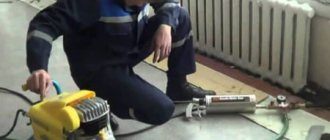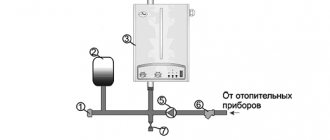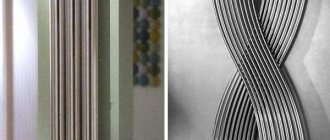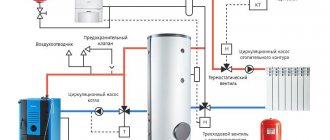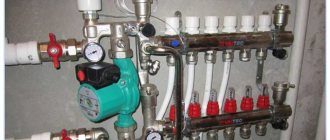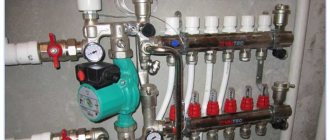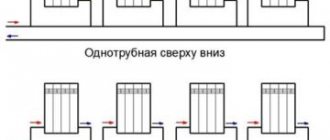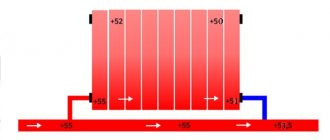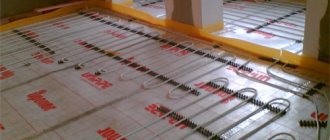The key problem of the classic one- and two-pipe heating system of private houses is the rapid cooling of the coolant. Agree that it would be nice to develop a system that is free of such a drawback.
Do you want to implement heating in your home where the coolant will be warm for as long as possible? We will help you solve this problem - the article discusses the collector heating system, which has been widely popular in recent years. It is she who is able to maintain the desired temperature inside the circuit for a long time.
Also in this material we looked at what principles underlie the system and what wiring diagram is the most convenient in terms of installation. The article contains diagrams and thematic photos, useful tips and videos about the features of the collector system and the nuances of installing radiators.
Pros and cons of the collector-beam system
Among the undeniable advantages of installing a collector system, it is worth highlighting:
- Ease of use . Due to the fact that each element is controlled independently, the consumer has the opportunity to set the temperature anywhere in the house. And as needed, it’s easy to turn off one or a group of heating devices in the room. At the same time, the temperature in other rooms will remain the same.
- Possibility to use small diameter pipes . Since each branch leading from the collector feeds only one device, small-diameter pipes that can be easily hidden in a screed can be used to lay it.
- Maintainability . If problems are detected, it will be easy to disconnect any section of the pipeline without interrupting the operation of the entire system.
To form several circuits with different parameters, for example: pressure drops or different media temperatures, distribution combs with a hydraulic compensator function are used.
The hydraulic arrow is a capacious pipe, to the outputs of which a number of circuits with independent circulation are connected.
The water heated by the boiler enters the hydraulic arrow. Circulating inside the device, water is taken at different distances from the taps and redistributed along the contours.
At the insertion points of each circuit after the hydraulic arrow, its own values of pressure drop and media temperature will be set
Due to the fact that the heated coolant delivers heat to the batteries with less loss, the efficiency of the system increases. This makes it possible to reduce the boiler power and thus save fuel consumption.
The heating system, the main element of which is the collector, is not without drawbacks.
These include:
- Pipe flow . When compared with a series connection, the pipe consumption when laying a collector system is two/three times higher. The difference in costs is determined by the size of the area involved.
- The need to use circulation pumps . The installation of independent circuits is not complete without the installation of circulation pumps. This entails additional costs.
The weak link of the collector system is its energy dependence. So even with the boiler running, in the event of a power outage, the pipes will remain cold. For this reason, such systems are not recommended for use in areas where power outages are common.
The circulation pump ensures forced movement of the coolant in a system made of pipes with a small diameter, in which the total hydraulic resistance is high
When laying contours in a floor screed, it is worth considering that any connection is a potential leak point. And if a defect occurs, the monolithic concrete will have to be opened to eliminate it. And this is already a very troublesome and costly undertaking.
Therefore, the connections of the collector system networks are located exclusively above the floor level. Most often they are confined to the manifold cabinet.
How to choose a distribution manifold
Manufacturers offer a fairly diverse range of collector systems, and craftsmen assemble such a device from improvised means. The choice depends on the location of operation, the cost of the product, the availability of automation, reliability and efficiency.
- The simplest option is a stainless steel pipe to which outlets for connecting radiators are welded. Despite its apparent simplicity, such a distribution comb will cost a considerable amount of money, because for ease of operation it will be necessary to install additional elements.
- A more reliable and inexpensive option is a manifold assembled from polypropylene pipes, connecting tees, necessary valves and stopcocks.
- If full automation in control is required, then it is better to choose a device with the maximum possible set of control elements. Flow meters and temperature sensors will help to evenly distribute the heat flow between radiators and underfloor heating circuits. True, the cost of such a model will be quite high.
In addition to economic factors, the choice of a collector may be influenced by technical operating conditions: maximum system pressure, electrical energy consumption by the device, the number of connected circuits and the potential for adding them. A collector heating system is only possible in modern new buildings, where additional valves are installed in each apartment to connect devices of various configurations.
Principles of drawing up wiring diagrams
There are no uniform planning standards when drawing up wiring diagrams for a collector system. Equipment is selected for specific tasks.
But experts agree on one authoritative opinion that such a system is in no way suitable for heating apartments. This is due to the complexity of the project due to the fact that two or more risers are usually supplied to the residential premises.
And one of the prerequisites for the implementation of the scheme is the need to connect all batteries to one riser.
You may also find useful information on how to connect a heating radiator.
To implement a collector wiring diagram in an apartment, you will have to leave only one heat channel, having previously welded the rest - it will take on the entire load
If you weld all the other water supply channels so that one riser takes on the entire load, a closed hydraulic circuit is formed within one apartment. All heating devices located higher up the riser will be cut off from the system and will not receive the desired heat.
Residents living above will sooner or later discover the reason for this phenomenon, and the scheme will have to be forcibly redone again, paying a considerable sum.
Manifold heating distribution can be installed in new apartment buildings, provided that additional valves were installed in them during the construction stage to connect circuits of various configurations.
When arranging a collector system, you should take into account a number of key points that are also typical for other types of systems
The collector system is ideally suited for private homes.
The main thing is to adhere to the basic recommendations of professionals when designing the wiring:
- Availability of an air vent . The automated valve is placed directly on the supply and return manifolds.
- Availability of expansion tank . Its volume indicator must be at least 3% relative to the total volume of coolant. But it is also possible to use devices with a larger volume.
- Location of the expansion tank . It is installed on the “return”, placing it in front of the circulation pump along the flow of water. More details about its installation are described in our other article.
- Installation of circulation pumps on each circuit . Their location is unimportant, but due to the low operating temperature they exhibit maximum efficiency on the return line.
If it is necessary to use a comb equipped with a hydraulic compensator, an expansion tank is installed in front of the main pump, which is designed to ensure the movement of water in a small circuit.
By placing an expansion tank in front of the pump, the risk of damage to the device due to water turbulence can be significantly reduced.
The circulation pump is fixed so that the shaft is strictly horizontal. Otherwise, the very first air lock will leave the unit without lubrication and cooling.
You can read more about choosing a circulation pump in this article.
If there are additional distribution nodes in the heating system, they should not be communicating.
Principle of operation
The main working element in the heating manifold circuit is the distribution unit, also called the comb.
This is a type of plumbing element of the system, used to distribute water heated from the boiler along independent pipelines. Also in the collector heating circuit are: a circulation pump, an expansion tank and automatic safety systems.
The main unit of the collector heating system in an apartment and a private house consists of several elements:
- Input - this element is connected to the boiler using a supply pipe, receives and distributes coolant throughout all rooms.
- Output - this element is connected to the return pipes, receives the cooled coolant and is responsible for redirecting it to the boiler.
In this video you will learn how to assemble a heating collector: The main difference between a collector system and a classic connection is that each heating radiator has independent wiring. This solution makes it possible to adjust the temperature of each heating device in a specific room, and, if necessary, turn it off completely.
Often, during heating design, a combined distribution scheme is used, in which several circuits are connected to the unit, all of which are controlled autonomously. But in the circuit itself, the heating devices are connected in series.
Selection of system components
When designing heating, it is best to purchase factory-made distribution units.
Thanks to the diversity of the range, it will not be difficult to select a comb for certain heating parameters, thereby ensuring the accuracy and reliability of the system.
On sale you can find ready-made manifold blocks that combine supply and return units, as well as thermostatic valves and automatic air vents
The key parameters when choosing pipes for heating circuits are corrosion resistance, heat resistance and high burst strength. In addition, the pipes must have the necessary flexibility so that they can be laid at any angle.
When choosing products, preference should be given to pipes produced in coils. The use of one-piece products will allow you to avoid connections in the wiring, which is especially important for closed installation methods inside the screed.
Pipes for private cottage systems
When designing heating in private houses, it is worth focusing on the fact that the pressure in the system is about 1.5 atmospheres, and the coolant temperature can reach:
- for radiators - 50-70 degrees;
- for heated floors - 30-40 degrees.
For autonomous heating systems with their predictable parameters, it is not at all necessary to purchase stainless corrugated pipes. Many owners limit themselves to purchasing pipes made of cross-linked polyethylene marked “PEX”.
Polyethylene pipes for heating circuits are available for sale in 200-meter coils; they are able to withstand pressure up to 10 kgf/kV.cm and operate at temperatures within 95 °C
Such pipes are joined using tension fittings, so that inextricable connections can be obtained.
In addition to high performance parameters, the main advantage of cross-linked polyethylene is the mechanical memory of the material. Therefore, if you forcefully stretch the edge of the pipe and insert a fitting into the resulting gap, it will tightly surround it, ensuring a strong connection.
When using metal-plastic pipes, the connection is made using union fittings with crimp nuts. And this already turns out to be a detachable connection, which, according to SNiP, cannot be “solidified”.
You may also find information about which pipes are best to choose for heating, discussed here.
Pipes for apartment buildings
If the collector system is installed in an apartment building, then it is worth considering that the operating pressure in it is 10-15 atmospheres, and the coolant temperature can reach about 100-120 °C. It should be remembered that collector heating is only possible on the ground floor.
The best option for installing the system in an apartment building is the use of corrugated pipes made of stainless steel.
A clear example of this is the products of the Korean company Kofulso. Pipes of this brand are capable of operating at a working pressure of 15 atmospheres and withstand temperatures of about 110 °C. The collapse pressure of Kofulso pipes reaches 210 kgf/sq.cm.
Due to the excellent flexibility of the pipe, in which the bending radius is equal to its diameter, the products are convenient to use when laying “warm floors”
Assembling pipeline connections using such elements is not difficult. The pipe is simply inserted into the fitting and secured by screwing on a nut, which compresses the corrugated metal surface with an elastic silicone seal.
Summarizing
The collector heating system can be called ideal in terms of efficiency. Independent supply of coolant to each radiator allows you to achieve an ideal microclimate in every room of the house. The high cost, compared to traditional heating schemes, somewhat restrains the growth in popularity of this type of home heating, but if the budget allows, then heating using a collector circuit is an ideal option.
In the video, attention is paid to the design of the comb.
Did you like the article? Subscribe to our Yandex.Zen channel
System installation features
The collector heating system of a private house should be installed during the construction stage. After all, after laying or pouring the finished floor, installing such a system will become economically infeasible. The only solution to the problem in this case will be an open method of wiring installation.
Installation of distribution comb
On the floors of houses with horizontal heating distribution, to accommodate the collector, circulation pump and control equipment, you will need to install a closed box - a collector cabinet.
A closed box will protect equipment and shut-off valves from external mechanical influence and give the room a more aesthetic appearance
The manifold cabinet is installed in separate niches of rooms protected from moisture. Most often, a place is allocated for this in the hallway, dressing room or pantry.
When designing the heating of a two-story building, it will be necessary to install two collector groups: on the first and second levels. Additional distribution units will ensure approximately the same length of the circuit.
As an option, you can take as a basis a scheme in which the first group will be responsible for the distribution of heat along individual circuits, and the second will act as a key component in arranging a “warm” floor.
The heated coolant from the room with the boiler flows through the main lines to the collectors installed floor-by-floor
The number of collector inputs and outputs is always equal to the number of heating elements located on the floor: radiators or underfloor heating rings. For each room, a separate branch is laid, which, by combining several heating devices, will implement a passing or dead-end circuit.
To reduce the cost of connecting radiators, a “pass-through” circuit is used.
In a “pass-through” scheme, the thermal valve is installed only on the first circuit of the radiator; due to which the water flow is regulated on all devices connected in series behind it
With a “pass-through” system, several devices connected in series will be perceived as one element.
Pipeline laying options
When collecting pipes, the most commonly used method is laying pipes in a concrete screed. Its thickness varies between 50-80 mm, which is quite enough to “monolithize” the intra-house wiring of the heating system.
But according to SNiP, only unbreakable connections are allowed to be laid in concrete.
Any radiator or convector is connected to the collector through two pipes: “supply” and “return”, so the pipes are laid in the floor screed in pairs
For this purpose, metal-plastic pipes with a diameter of 16 mm are often used. Due to the fact that they bend easily, it is convenient to lay the pipeline under the floor.
When planning to fill metal-plastic pipes with concrete screed after pressure testing of the system, it is necessary to first wrap them with thermal insulation.
Such a layer will minimize the risk of pipe damage due to thermal expansion, since in this case they will “rub” not against the concrete, but against the insulation.
When laying pipes in a screed, connections in accordance with the requirements of SNiP must be left accessible, placing them above the floor level for this purpose
Plywood is laid on top of the screed, which is covered with a finishing floor covering: linoleum or parquet.
Pipes can also be connected to radiators from the side or from above, for example: in the space of a false ceiling.
Some craftsmen prefer to lay pipes externally, placing them along the walls and hiding them behind decorative skirting boards. But this method of installation entails an inevitable increase in the length of the pipeline.
It is not recommended to lay the pipeline through doorways. This can lead to the fact that when installing the threshold of an interior door, the pipe will be damaged at the time of drilling.
If the pipeline needs to be laid through a wall, in order to prevent its damage due to shrinkage of the building, the hole in the wall should be equipped with a sleeve.
A separate shut-off valve is installed on each hydraulic circuit coming from the distribution comb.
To be able to bleed the air accumulated in the system, install:
- on the distribution unit - air release valves;
- on radiators (accumulates at the highest points) - Mayevsky taps.
Due to the fact that each hydraulic circuit coming after the collectors is an independent system, it is convenient to use when creating “warm floors”.
The main advantage of a floor-mounted collector system is that heat flows are distributed evenly across the floor
Air circulation when arranging the floor option occurs naturally.
When implementing such a system, metal-plastic pipes are laid on a heat-insulating pad, forming a pattern in the form of a snake or spiral. The diameter of the pipes and the laying pitch are determined according to calculations. One condition is that the length of one circuit should not exceed 90 meters.
The laid circuits are connected to the distribution unit, and after checking the tightness of the connections, they are filled with concrete mortar. The height of the screed is 70-90 mm.
The same principle is used to install both the collector system of a two-story cottage and a residential building with a large number of floors.
Tips for installing a warm water floor collector
Using a factory kit eliminates a number of common mistakes when installing a unit. The finished manifold group for underfloor heating is already equipped with the necessary valves and other important elements.
Be sure to consider the following recommendations:
- The calculation of the thermal load on the circuit is calculated before installation, and based on the data obtained, the balancing valve is adjusted;
- The cabinet for the mixing unit is placed in a place located at the same distance from the connected pipes;
- The dimensions of the collector box should be selected according to the dimensions of the device;
- Under the block, be sure to provide space for bending each contour;
- For a possible increase in water circuits, it is worth leaving several free pipes;
- The most efficient heating system is obtained by introducing a powerful circulation pump;
- When installing multiple pumps, be sure to use check valves.
Diagram of pump-mixing and manifold assembly
Among other things, it is better to entrust the development of a heating floor collector circuit to professionals, even if you plan to assemble it yourself. The fact is that making accurate calculations without the appropriate knowledge is quite problematic. Saving on a qualified calculation of the parameters of the collector unit can lead to serious costs in the future.
